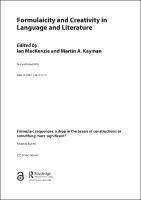Chapter 1 Formulaic sequences: a drop in the ocean of constructions or something more significant?
Proposal review
| dc.contributor.author | Buerki, Andreas | |
| dc.date.accessioned | 2019-10-17 14:35:34 | |
| dc.date.accessioned | 2020-04-01T11:00:03Z | |
| dc.date.accessioned | 2018-12-01 23:55:55 | |
| dc.date.accessioned | 2019-10-17 14:35:34 | |
| dc.date.accessioned | 2020-04-01T11:00:03Z | |
| dc.date.available | 2020-04-01T11:00:03Z | |
| dc.date.issued | 2018 | |
| dc.identifier | 1003976 | |
| dc.identifier | OCN: 1082953416 | en_US |
| dc.identifier.uri | http://library.oapen.org/handle/20.500.12657/26111 | |
| dc.description.abstract | This article investigates how formulaic sequences fi t into a constructionist approach to grammar, which is a major post- Chomskyan family of approaches to linguistic structure. The author considers whether, in this framework, formulaic sequences represent a phenomenon that is suffi ciently diff erent to warrant special status or whether they might best be studied in terms of the larger set of all constructions found in language. Based on data drawn from a large corpus of Wikipedia texts, it is argued that it is extremely diffi cult to form a distinct class of formulaic sequences without creating highly arbitrary boundaries. On the other hand, based on existing theoretical claims that formulaic sequences are the basis of fi rst language acquisition, a marker of profi ciency in a language, critical to the success of communicative acts and key to rapid language processing, it is argued that formulaic sequences as constructions are nevertheless signifi cant enough to be the focus of research, and a theoretical category meriting particular attention. These fi ndings have key repercussions both for research primarily interested in formulaic language and phraseology as well as for construction grammatical research. | |
| dc.language | English | |
| dc.subject.classification | thema EDItEUR::D Biography, Literature and Literary studies | en_US |
| dc.subject.other | Fornulaic sequences | |
| dc.subject.other | grammar | |
| dc.subject.other | linguistic structure | |
| dc.title | Chapter 1 Formulaic sequences: a drop in the ocean of constructions or something more significant? | |
| dc.type | chapter | |
| oapen.relation.isPublishedBy | 7b3c7b10-5b1e-40b3-860e-c6dd5197f0bb | |
| oapen.relation.isPartOfBook | b44090e1-5157-4f9a-afe6-efdec3bc6c03 | |
| oapen.imprint | Routledge | |
| oapen.pages | 24 | |
| oapen.remark.public | 3-8-2020 - No DOI registered in CrossRef for ISBN 9781138721579 | |
| oapen.identifier.ocn | 1082953416 | |
| peerreview.anonymity | Single-anonymised | |
| peerreview.id | bc80075c-96cc-4740-a9f3-a234bc2598f1 | |
| peerreview.open.review | No | |
| peerreview.publish.responsibility | Publisher | |
| peerreview.review.stage | Pre-publication | |
| peerreview.review.type | Proposal | |
| peerreview.reviewer.type | Internal editor | |
| peerreview.reviewer.type | External peer reviewer | |
| peerreview.title | Proposal review | |
| oapen.review.comments | Taylor & Francis open access titles are reviewed as a minimum at proposal stage by at least two external peer reviewers and an internal editor (additional reviews may be sought and additional content reviewed as required). |

